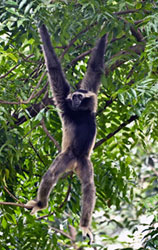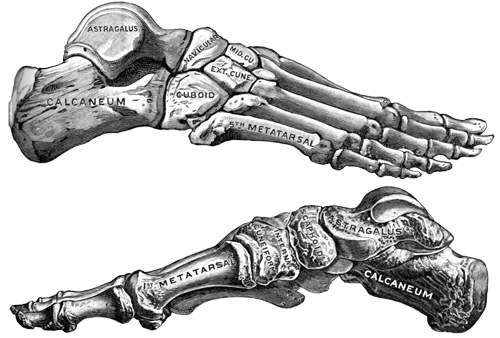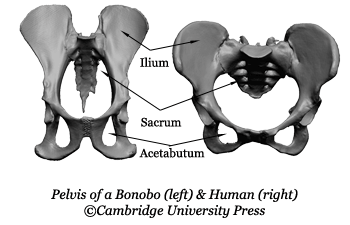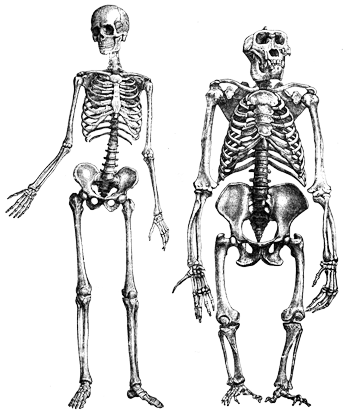
It has long been recognized that humans are essentially just another variety of ape and, like them are classified as members of the Hominoidea ‘superfamily’. After all, we share almost 99% of our DNA with chimpanzees. The prevailing wisdom a hundred years ago was that there were three essential qualities that separated us from the apes—large brains, tool making, and the ability to move about on our hind legs. As it turns out, apes are just as capable of manufacturing and using tools as humans are and, to begin with at any rate, there is not a lot of difference in the size of their brains. It now appears that what really separates us from the apes is bipedalism. While many apes are capable of standing upright and taking a few steps on their back feet, only humans are fully bipedal and able to cover long distances in that posture. All apes were forest dwellers and retained many skeletal features adapted to that lifestyle. Spending much of their time up in the trees, the earliest apes and most of their living descendants retain many features ‘designed’ for moving among the branches.
Both methods of locomotion involved changes to the hominoid skeletal structure and, since this evidence makes up the vast bulk of the archaeological record it is important to recognize them.
brachiation
_-_Fig._162.png) Apes (hominoids) have two principal means of locomotion. On the ground they are quadrupeds, most often using a method known as ‘knuckle walking’ but, up in the trees, they have developed a technique known as brachiation. This involves climbing using your hands and feet and swinging from branch to branch using your arms and has resulted in a number of changes to their skeletons and musculature, the most important being in the upper body—the shoulders and the arms.
Apes (hominoids) have two principal means of locomotion. On the ground they are quadrupeds, most often using a method known as ‘knuckle walking’ but, up in the trees, they have developed a technique known as brachiation. This involves climbing using your hands and feet and swinging from branch to branch using your arms and has resulted in a number of changes to their skeletons and musculature, the most important being in the upper body—the shoulders and the arms.
The hominoid shoulder girdle was entirely remodelled. The collarbone (clavicle) became longer and much more robust pushing the shoulder blade (scapula) from the side towards the back of the body. The arm socket (glenoid fossa) shifted along with it, making the shoulder joints much more mobile than those of any earlier primate. The ‘arm’ (formerly the foreleg) could now move freely to the side as well as up and over the head, something no quadruped able to do.
Mammals that walk on four legs have a ribcage (thorax) that is deep rather than broad since most of it hangs down from the spine. The opposite is the case with apes, which means that the weight is more evenly distributed along the vertical axis. Quadrupeds also have more massive back (epaxial) muscles because their principal means of propulsion involves driving the body forward with a whip crack motion along  the spine. However, when it comes to brachiation, these muscles play much less of a role and become somewhat reduced in size. For similar reasons, the length of the spine becomes relatively shorter as some of the lowest vertebrae in the lumbar region fuse together to form the sacrum.
the spine. However, when it comes to brachiation, these muscles play much less of a role and become somewhat reduced in size. For similar reasons, the length of the spine becomes relatively shorter as some of the lowest vertebrae in the lumbar region fuse together to form the sacrum.
Most quadrupeds have a considerable amount of curvature in their forelegs to provide some cushioning while bounding along the ground but that was no longer a vital consideration as far as the apes were concerned. The long bones of their arms, the humerus (upper arm) and the radius and ulna (forearm) are virtually straight and the elbow joint was adjusted to enable the arm to fully extend. The hominoid wrist (carpus) does not directly abut the ulna but is connected by ligaments. This means that it is much looser and can fully extend either up (supinated) or down (pronated). It can also be rotated on the horizontal axis so that the hand can be used more effectively for climbing. Swinging from branch to branch requires strong forearm muscles and, among  the apes, the radius and ulna curve away from each other to accommodate them.
the apes, the radius and ulna curve away from each other to accommodate them.
A firm grip is also essential for brachiation and, for that reason, the hominoid finger bones (phalanges) are long, robust and have a slight inward curve. All apes, including us, have opposable thumbs that enabled them to wrap their hands around whatever they are hanging on to. Unlike us, however, most apes also have opposable big toes (hallux) so they can get a firm grip with all four limbs. This means that one or both hands can be freed up for other purposes—plucking fruit, for example.
These changes are more pronounced in some apes than others. Gibbons (left) are the most adapted to the aerial lifestyle and the most acrobatic, while the heavier ‘great apes’ such as gorillas and chimps are more comfortable on the ground.
Bipedalism
The early apes were all quadrupeds—as are all of their living descendants apart from us. That means they moved about on all fours, mostly on the ground but often up in the trees with the rest of the primates. Their bodies were still largely framed for a life of climbing and clambering. They generally slept in the trees, coming down to the forest floor to search for food. They were not well-adapted for covering long distances in open country and rarely ventured too far away from the trees. But we (and our immediate predecessors, the Australopithecines) have had to do just that—even though this eventually meant having to spend all of our time on the ground. However, in order to be successful, changes to our physical structure were necessary, changes that involved the shape and the relative size of their bones. It is far easier to maintain balance on four legs than two if the body weight is not distributed evenly. This involved changes to the structure of the spine, the thorax and the pelvis. To move efficiently on two legs required changes to the lower limbs and feet.
Unfortunately, unconnected bits and pieces of the skeleton are the only things likely to survive as fossils. Early hominins did not bury their dead and the majority of them were either dismembered by predators or left to rot and be fought over by scavengers. However, it is possible to recreate the arrangement of the skeleton to some extent even if no complete example is found. Markings on the bones and the formation of knobby looking projections known as condyles say a lot about the way the various muscles, tendons and ligaments were attached. Even so, the question of when bipedalism first appeared was all somewhat speculative until 1976 when Mary Leakey discovered several sets of footprints made by bipedal hominins, preserved in volcanic ash laid down some 3.7 million years ago. More recently discovered species such as Orrorin tugenensis and members of the genus Ardipithecus have shown that bipedal hominins had been around for two or three million years before that.
Bipedalism and an upright posture had a number of advantages for early hominins. It enabled them to raise their heads about the tall grasses and shrubs and scan the distance for sources of food and keep an eye out for predators. It also freed the hands for gathering fruit, holding tools and weapons, and carrying food supplies not to mention helpless infants. Eventually, as the physical changes slowly took hold and hominins developed a more even and balanced gait which would help them enormously as hunting became an important means of subsistence. Most of the four-legged game they pursued was quite a bit faster than them over short distances, but humans had more endurance in the chase and were often able to run them into the ground.
_-_Fig._145.png) Bipedalism and an upright posture had a number of advantages for early hominins. It enabled them to raise their heads about the tall grasses and shrubs and scan the distance for sources of food and keep an eye out for potential predators. It also freed the hands for gathering fruit, holding tools and weapons, and carrying food supplies as well as vulnerable infants. Eventually, as the physical changes slowly took hold and hominins developed a more even and balanced gait which would help them enormously as they transitioned into hunting. Most of the four-legged game they pursued was quite a bit faster than them over short distances, but humans had much more endurance and were generally able to run them to ground.
Bipedalism and an upright posture had a number of advantages for early hominins. It enabled them to raise their heads about the tall grasses and shrubs and scan the distance for sources of food and keep an eye out for potential predators. It also freed the hands for gathering fruit, holding tools and weapons, and carrying food supplies as well as vulnerable infants. Eventually, as the physical changes slowly took hold and hominins developed a more even and balanced gait which would help them enormously as they transitioned into hunting. Most of the four-legged game they pursued was quite a bit faster than them over short distances, but humans had much more endurance and were generally able to run them to ground.
The Spine
The most important changes begin with the vertebral column, which has to support all the weight of the upper body. Most apes, even when standing on two legs, have a fairly straight spine that runs from the sacrum to the neck. The human spine (left), on the other hand, is shaped like an elongated S. The curvature (lordosis) of our cervical vertebrae tilts the skull backwards so that is balanced on top of the neck. Similarly, the lordosis of our lumbar region tilts the entire upper body backwards so that it is balance on top of our sacrum at the base of the spine. These lordoses are the result of the wedge-shaped disks of cartilage that separate the vertebrae—the ones that cause most of our lower back problems.
Pelvis and Hip
The human pelvis is made up of two principal elements—the sacrum, which is formed by the fusion of the lower vertebrae; and the ilium, which is the fan shaped upper part of the hip bone. In humans, the sacrum is shorter and broader than that of an ape, consisting of only 5 fused vertebrae, and pulls the pelvis down and back so that the spine is more vertical and the upper body  better balanced. The tendency to tip over backward is held in check by the large iliofemoral ligament that runs from the ilium to the top of the thigh bone (femur). The point where they attach,, the intertrochanteric line, can be easily recognized and are either reduced or entirely missing among the apes. To further stabilize the hip we have developed powerful gluteus maximus muscles that run along the back of the femur and connect to the ilium. These are not particularly useful for normal activities but when it comes to running, climbing a hill or springing up from a squat, they come in very handy indeed.
better balanced. The tendency to tip over backward is held in check by the large iliofemoral ligament that runs from the ilium to the top of the thigh bone (femur). The point where they attach,, the intertrochanteric line, can be easily recognized and are either reduced or entirely missing among the apes. To further stabilize the hip we have developed powerful gluteus maximus muscles that run along the back of the femur and connect to the ilium. These are not particularly useful for normal activities but when it comes to running, climbing a hill or springing up from a squat, they come in very handy indeed.
These adaptations come at a cost, however. The pelvic opening is much smaller in humans and this makes childbirth very difficult if not positively dangerous—especially as the evolving skull of the infant increases in size. Adjustments in the width of the pelvis and the enlargement of the size of the opening among females of our species reduces the risk somewhat, but it is far from an easy experience.
Knee
The knee is the point where the two major leg bones, the femur and the shin bones (tibia and fibula) connect, and its construction enables an animal to propel itself forward by bending and straightening in a single direction while at the same time keeping the leg stable. Most  apes move quadrapedally on the ground, using a galloping motion when in a hurry. They never fully extend their hind legs—otherwise the body would collapse under its own weight when the feet hit the ground. They use their leg muscles to do the work. It is the job of the quadriceps, which runs down the front of the femur, to extend the leg forwards while the hamstrings on the opposite side hold them in check and prevent the leg from straightening out.The knee is the point where the two major leg bones, the femur and the shin bones (tibia and fibula) connect, and its construction enables an animal to propel itself forward by bending and straightening in a single direction while at the same time keeping the leg stable.
apes move quadrapedally on the ground, using a galloping motion when in a hurry. They never fully extend their hind legs—otherwise the body would collapse under its own weight when the feet hit the ground. They use their leg muscles to do the work. It is the job of the quadriceps, which runs down the front of the femur, to extend the leg forwards while the hamstrings on the opposite side hold them in check and prevent the leg from straightening out.The knee is the point where the two major leg bones, the femur and the shin bones (tibia and fibula) connect, and its construction enables an animal to propel itself forward by bending and straightening in a single direction while at the same time keeping the leg stable.
Most apes move quadrapedally on the ground, ![]() using a galloping motion when in a hurry. They never fully extend their hind legs—otherwise the body would collapse under its own weight when the feet hit the ground. They use their leg muscles to do the work. It is the job of the quadriceps, which runs down the front of the femur, to extend the leg forwards while the hamstrings on the opposite side hold them in check and prevent the leg from straightening out.
using a galloping motion when in a hurry. They never fully extend their hind legs—otherwise the body would collapse under its own weight when the feet hit the ground. They use their leg muscles to do the work. It is the job of the quadriceps, which runs down the front of the femur, to extend the leg forwards while the hamstrings on the opposite side hold them in check and prevent the leg from straightening out.
Humans, on the other hand, keep the knee extended while the foot is on the ground, so there is no need for such massive leg muscles. Our forward motion is propelled by raising our heels and thrusting forward with our toes, flexing our knees as we do. We are able to ‘lock’ our knees which are kept in place by ligaments that are connected to the condyles of the femur as well as those of the tibia and fibula. The femoral condyles are elliptical in humans, which keeps the ligaments taut when the leg is fully extended. The corresponding condyles on the ape are much rounder, allowing for much more flexibility.
In addition, while most apes are bow-legged, humans are knock-kneed (valgus, in medical terminology). In us, the femur runs at an angle from the hip joint (acetabulum) to the knee. This gives us better balance when moving forward and shifting our weight from one foot to the other. Because the angle of the joint between the fibula and tibia, known as the bicondylar angle, is significantly greater than that of apes and one of the principal identifiers of hominin lineage.
Feet
Most other primates have prehensile hind feet, with a divergent big toe (hallux) that operates like the thumb of a human hand, well adapted for climbing and moving along branches. Human feet are used almost entirely for locomotion—running or walking—and have undergone a long series of changes that have turned it into a more rigid structure, dedicated to supporting the weight of the body while doing so. There is a distinct possibility that the trend to bipedalism began with walking along branches using the feet while balancing and steadying oneself with the arms.
Probably the most important was the development of a longitudinal arch (instep) so that when we walk the weight is borne by the toes and the heel. Apes have what is known as a ‘midtarsal break’ which prevents them from raising their heel while keeping their toes on the ground. This sort of ‘flat-footedness’ would have been enough to keep them out of the army. To prevent the arch from collapsing a long tendon known as the plantar aponeurosis, which runs from the heel to the base of the toes (dorsal metatarsals), aided by a system of ligaments, which would have put a ‘spring’ in our step. Our ‘big toe’ is aligned (adducted) with the others and bound to them by a ligament, but is longer and sturdier than the rest of the phalanges because it is used for pushing off when walking or running when it carries most of the weight of the body.

The Structure of the Human Foot.
The heel is the first part of the foot to hit the ground when moving forward. This can be jarring and so adjustments were made to the bones that make up the back of the foot. The calcaneus, which was the point of impact, became enlarged and elongated to absorb the shock and the others (the talus, cuboid and various cuneiform bones) were reshaped to strengthen our arches. This enables us to shift our weight from the heel to the ball of our foot (metatarsal heads) instantaneously.
Connecting the foot with the rest of the leg is the ankle (the talus), which varies in shape according to whether the foot is used for climbing or for walking. Apes need to have a very flexible ankle to clasp and then push off with the foot while climbing (dorsiflexion). We humans are quite capable of climbing trees but we are not brilliant at it. Most of the dorsiflexion in our legs is found in the toes (phalanges), which are rather stumpy when compared to the rest of the apes.
Skull
There are quite a number of differences in the size and shape of the ape and human skulls but most of these have to do with increased brain size and diet and will be discussed elsewhere. As far as those connected with locomotion are concerned, the most notable is thepositions of the foramen magnum, the hole through which the spinal cord connects to the brain, and of  the occipital condyles on either side of it, where the vertebral column articulates with the skull. These are located toward the back of the ape skull, but are angled forward in humans—appropriate to their upright posture. The foramen is also more centrally located so that the head is nicely balanced on top of the spine; ape heads tend to hang forward and require strong neck muscles attached to the back of the skull. In the case of larger apes this had required a nuchal crest, a boney protuberance that flares out from the back of the skull where the temporalis muscles attach.
the occipital condyles on either side of it, where the vertebral column articulates with the skull. These are located toward the back of the ape skull, but are angled forward in humans—appropriate to their upright posture. The foramen is also more centrally located so that the head is nicely balanced on top of the spine; ape heads tend to hang forward and require strong neck muscles attached to the back of the skull. In the case of larger apes this had required a nuchal crest, a boney protuberance that flares out from the back of the skull where the temporalis muscles attach.




_-_Fig-231.png)
